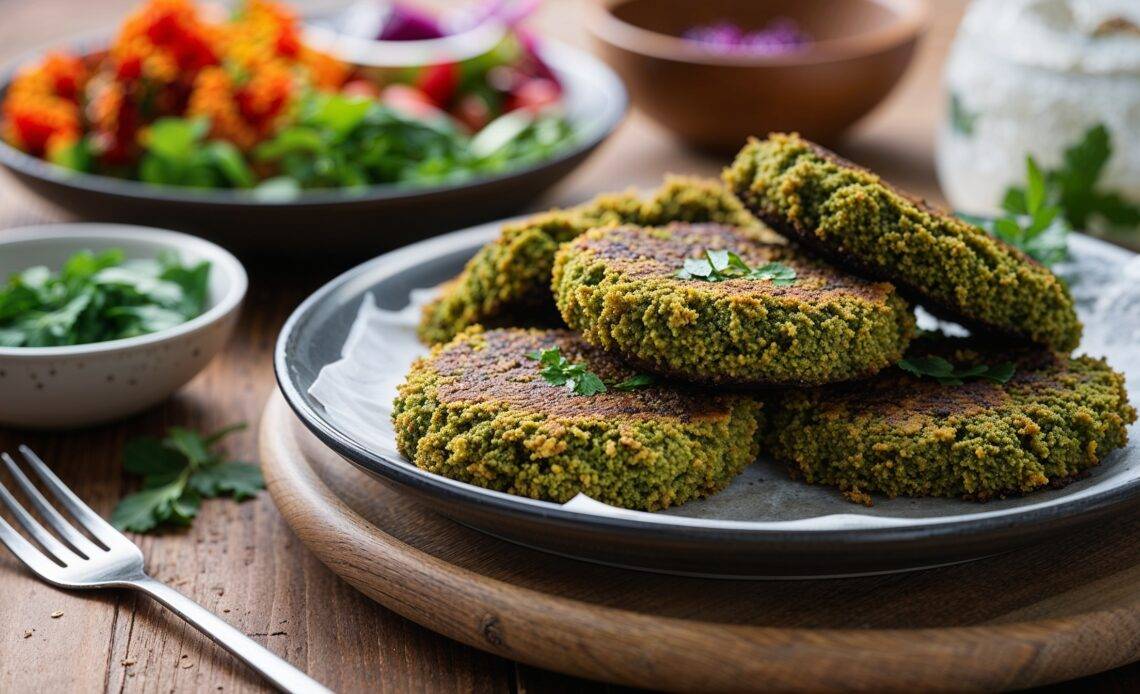
Falafel Recipe, with its crispy exterior, flavorful herbs, and soft, savory interior, has captivated food lovers around the world. Originally from the Middle East, this beloved dish is a street food staple and a favorite homemade treat. Whether you’ve enjoyed falafel at a Mediterranean restaurant or during a street food experience, making it fresh at home adds a special touch. With this simple recipe, you’ll discover the authentic taste of this classic dish, crafted from high-quality, flavorful ingredients.
Read more: Easy, Authentic, and Delicious: The Ultimate Falafel RecipeFalafel Recipe: A Culinary Delight from the Middle East
Falafel, recognized for its crunchy shell and tender, flavorful core, has enchanted gastronomes globally. This culinary delight, originally from the Middle East, is a common sight in street food stalls and a cherished homemade delicacy.
Whether you’ve savored falafel at a Mediterranean restaurant or during a street food experience, making it at home adds a personal touch. This simple recipe will help you recreate the authentic taste of this classic dish using high-quality, flavorful ingredients.
Start with soaked chickpeas, fresh herbs like parsley and coriander, and aromatic spices like cumin and coriander. Blend these ingredients into a coarse mixture, shape them into balls or patties, and deep-fry until golden brown. The result is a crispy, flavorful falafel that’s perfect on its own or tucked into a warm pita with fresh vegetables and a drizzle of tahini sauce.
Making falafel at home not only allows you to control the quality of ingredients but also lets you adjust the flavors to your liking. So, roll up your sleeves and get ready to experience the joy of making and eating homemade falafel.
If you’re ready to recreate restaurant-quality falafel in your own kitchen, let’s jump into this step-by-step guide!
Frequently Asked Questions (FAQs)
1. What oil is best for frying Falafel Recipe?
High-smoke-point oils like canola, sunflower, or peanut oil work best as they can withstand frying temperatures.
2. Can I freeze Falafel Recipe?
Yes! After frying or baking, cool the falafel completely, then store in an airtight container or freezer bag. Reheat in the oven for the best results.
3. What should I serve with Falafel Recipe?
Pair falafel with pita bread, hummus, fresh vegetables, or tahini sauce for a complete meal.
4. Can I use canned chickpeas?
Canned chickpeas can lead to a mushier texture, making the falafel harder to fry. Soaked, uncooked chickpeas yield the best results.
5. How can I make my falafel extra crispy?
Using soaked chickpeas and not over-pulsing the mixture can create a crispier texture. If baking, a light spray of oil before baking helps enhance crispiness.
Overview of Falafel
Falafel recipe is a popular Middle Eastern dish made from ground legumes, typically chickpeas or fava beans, mixed with herbs and spices, then deep-fried or baked. It has become a staple in vegetarian and vegan diets due to its high protein content and satisfying texture.
Historical Origins
The exact origins of falafel recipe are somewhat unclear, but it is widely believed to have originated in Egypt around 1000 years ago, likely brought to prominence by Egyptian Copts. This theory suggests that falafel was initially made from fava beans, which were more commonly used in ancient Egyptian cuisine.As falafel spread throughout the Middle East, it evolved and adapted to local tastes and ingredients. In Israel, for example, it became a symbol of national identity, with various claims about its origins leading to cultural debates between Jewish and Arab communities.
Traditional Ingredients and Preparation
Historically, falafel was primarily made with fava beans, but modern recipes often use chickpeas as well. The preparation involves soaking the legumes, grinding them with herbs like parsley and cilantro, and mixing in spices such as cumin and coriander. The mixture is then shaped into balls or patties and fried until crispy 1.
Cultural Significance
Falafel has transcended its origins to become a beloved street food across the globe. It is often served in pita bread with various toppings, including tahini sauce, pickled vegetables, and fresh salads. Its popularity among vegetarians and vegans has further solidified its status as a versatile and nutritious alternative to meat-based dishes 2.In summary, falafel’s rich history reflects a blend of cultural influences and culinary traditions, making it not just a dish but a symbol of the diverse food heritage of the Middle East.
